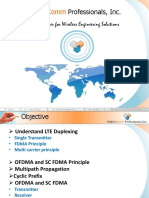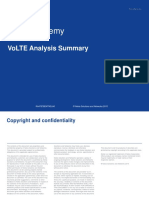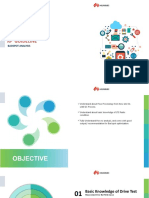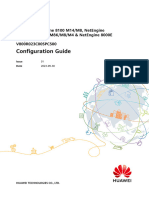LTE49 Paging
LTE49 Paging
Uploaded by
moustafa.aymanCopyright:
Available Formats
LTE49 Paging
LTE49 Paging
Uploaded by
moustafa.aymanCopyright
Available Formats
Share this document
Did you find this document useful?
Is this content inappropriate?
Copyright:
Available Formats
LTE49 Paging
LTE49 Paging
Uploaded by
moustafa.aymanCopyright:
Available Formats
No further reproduction or networking is permitted. Distributed by Nokia.
Copyrighted material licensed to ashrakat.badr.ext@nokia.com on 29-09-2022.
Single RAN Features, Rel. SRAN
21A, Operating Documentation,
Issue 06
LTE49: Paging
DN251053019
Issue 01
© 2022 Nokia. Nokia Condential Information
Use subject to agreed restrictions on disclosure and use.
LTE49: Paging
No further reproduction or networking is permitted. Distributed by Nokia.
Copyrighted material licensed to ashrakat.badr.ext@nokia.com on 29-09-2022.
Nokia is committed to diversity and inclusion. We are continuously reviewing our customer
documentation and consulting with standards bodies to ensure that terminology is inclusive
and aligned with the industry. Our future customer documentation will be updated
accordingly.
This document includes Nokia proprietary and condential information, which may not be
distributed or disclosed to any third parties without the prior written consent of Nokia. This
document is intended for use by Nokia’s customers (“You”/”Your”) in connection with a
product purchased or licensed from any company within Nokia Group of Companies. Use this
document as agreed. You agree to notify Nokia of any errors you may nd in this document;
however, should you elect to use this document for any purpose(s) for which it is not
intended, You understand and warrant that any determinations You may make or actions
You may take will be based upon Your independent judgment and analysis of the content of
this document.
Nokia reserves the right to make changes to this document without notice. At all times, the
controlling version is the one available on Nokia’s site.
No part of this document may be modied.
NO WARRANTY OF ANY KIND, EITHER EXPRESS OR IMPLIED, INCLUDING BUT NOT LIMITED TO
ANY WARRANTY OF AVAILABILITY, ACCURACY, RELIABILITY, TITLE, NON-INFRINGEMENT,
MERCHANTABILITY OR FITNESS FOR A PARTICULAR PURPOSE, IS MADE IN RELATION TO THE
CONTENT OF THIS DOCUMENT. IN NO EVENT WILL NOKIA BE LIABLE FOR ANY DAMAGES,
INCLUDING BUT NOT LIMITED TO SPECIAL, DIRECT, INDIRECT, INCIDENTAL OR
CONSEQUENTIAL OR ANY LOSSES, SUCH AS BUT NOT LIMITED TO LOSS OF PROFIT,
REVENUE, BUSINESS INTERRUPTION, BUSINESS OPPORTUNITY OR DATA THAT MAY ARISE
FROM THE USE OF THIS DOCUMENT OR THE INFORMATION IN IT, EVEN IN THE CASE OF
ERRORS IN OR OMISSIONS FROM THIS DOCUMENT OR ITS CONTENT.
Copyright and trademark: Nokia is a registered trademark of Nokia Corporation. Other
product names mentioned in this document may be trademarks of their respective owners.
© 2022 Nokia.
2 © 2022 Nokia. Nokia Confidential Information Issue 01
Use subject to agreed restrictions on disclosure and use.
LTE49: Paging
No further reproduction or networking is permitted. Distributed by Nokia.
Copyrighted material licensed to ashrakat.badr.ext@nokia.com on 29-09-2022.
Table of Contents
1 Introduction to the feature ......................................................................................................... 5
2 Benefits .......................................................................................................................................... 6
3 Functional description .................................................................................................................. 7
4 System impact ............................................................................................................................... 9
5 LTE49 reference data ................................................................................................................ 10
Issue 01. © 2022 Nokia. Nokia Confidential Information 3
Use subject to agreed restrictions on disclosure and use.
LTE49: Paging
No further reproduction or networking is permitted. Distributed by Nokia.
Copyrighted material licensed to ashrakat.badr.ext@nokia.com on 29-09-2022.
List of Tables
Table 1 Parameters introduced by LTE49 ................................................................................ 11
4 © 2022 Nokia. Nokia Confidential Information Issue 01
Use subject to agreed restrictions on disclosure and use.
LTE49: Paging
No further reproduction or networking is permitted. Distributed by Nokia.
Copyrighted material licensed to ashrakat.badr.ext@nokia.com on 29-09-2022.
1. Introduction to the feature
UE terminated service requests for connection with an UE in LTE_IDLE state.
The paging functionality consists of two components:
Paging on S1 via S1AP
Paging on Uu via RRC
The paging messages are scheduled in the time domain. The scheduling is based on UE-
specific DRX settings. The eNB supports cell specifc tracking areas (TA).
Issue 01. © 2022 Nokia. Nokia Confidential Information 5
Use subject to agreed restrictions on disclosure and use.
LTE49: Paging
No further reproduction or networking is permitted. Distributed by Nokia.
Copyrighted material licensed to ashrakat.badr.ext@nokia.com on 29-09-2022.
2. Benefits
The LTE system can contact the UE when the core network gets a request for a connection
to it from another device.
6 © 2022 Nokia. Nokia Confidential Information Issue 01
Use subject to agreed restrictions on disclosure and use.
LTE49: Paging
No further reproduction or networking is permitted. Distributed by Nokia.
Copyrighted material licensed to ashrakat.badr.ext@nokia.com on 29-09-2022.
3. Functional description
Functional overview
Paging is a network-initiated procedure to find and contact a UE. The UE, which is in idle
mode and attached to the LTE network, listens regularly to the broadcasted paging
messages. When the UE detects a message intended to it, it initiates an access procedure to
connect to the network. As a result of a successful connect procedure, a radio bearer is
established and the state of the UE changes to RRC_CONNECTED.
The functional description part for paging describes the message flow applied and the
paging messages involved. Additionally, the discontinuous reception mechanism is explained
by which the UE has to monitor only a small fraction of subframes of a radio frame to detect
paging indications.
Paging is initiated by the mobile management entity (MME) as a function of the non-access
stratum (NAS). The MME sends paging messages via S1 interface to the relevant eNBs. The
eNBs are determined by the tracking areas (maintained in the MME) where the UE is
expected to be located. In the eNBs and between the UE and the eNB, paging is included in
the radio resource control (RRC) protocol which is a part of the access stratum (AS).
There are several reasons why the network needs to contact a UE. The most common is
when downlink data, that are to be delivered to a UE, arrives at the serving gateway (S-GW).
Another example is when the indication of a system configuration changes. In order to
contact a UE, a paging procedure is initiated. In case of arriving of the downlink data at the
S-GW, the S-GW requests the MME to page the UE. The MME then triggers a paging
procedure as it is responsible for UE tracking. Its role involves control, execution, and
supervision of the procedure. These functions are realized using the S1AP protocol. The
MME starts paging by distributing a PAGING message to all eNBs that are related to the cells
corresponding to the UE's registered tracking areas. The MME also coordinates paging
responses and supervises the process by scheduling retransmissions of PAGING messages.
The eNB, having received the paging request from the MME, allocates resources, schedules
the paging process related to the air interface, and transmits the PAGING messages in the
radio cells involved. The scheduling takes into account DRX (discontinuous reception) of the
UE. Once the UE has detected that it is being paged, it initiates a standard random access
procedure.
Issue 01. © 2022 Nokia. Nokia Confidential Information 7
Use subject to agreed restrictions on disclosure and use.
LTE49: Paging
No further reproduction or networking is permitted. Distributed by Nokia.
Copyrighted material licensed to ashrakat.badr.ext@nokia.com on 29-09-2022.
Procedure and message flow
A UE that is attached to the network and is in idle state (ECM-IDLE) is traceable only to its
tracking areas (TAs) registered in the serving MME (as part of the mobility information kept
in the UE’s context). Every time the network needs to contact such a UE, a paging procedure
is performed taking into account the TAs.
The following steps are performed during paging:
1. The MME starts the paging procedure by sending a PAGING message via S1 interface to
each eNB belonging to one of the UE’s tracking areas. This message is part of the S1AP
protocol.
2. The eNBs derive the destination cells for the paging request.
3. For each destination cell, the related eNB calculates the radio frames for the paging
request and schedules (per cell) the paging request accordingly.
4. The eNBs transmit PAGING messages to the indicated cells according to the scheduling.
These messages are part of the RRC layer.
5. The addressed UE receives and decodes the PAGING message.
The UE responds to the successfully decoded PAGING message by initiating a random
access procedure in order to establish a connection to the network.
From the eNB perspective, multiple paging requests can arrive on S1 before they are
actually sent out on the Uu interface. They may need to be scheduled for the same or for
different paging occasions. Different paging requests scheduled for the same cell and
paging frame have to be transmitted on Uu within the same RRC: PAGING message.
Therefore, the eNB has to collect and buffer the received paging requests according to their
destination cells and their schedule. For each cell and at each paging frame with at least one
scheduled paging request, the eNB has to setup and send an RRC: PAGING message
including all paging requests scheduled for that same paging frame to the UEs.
8 © 2022 Nokia. Nokia Confidential Information Issue 01
Use subject to agreed restrictions on disclosure and use.
LTE49: Paging
No further reproduction or networking is permitted. Distributed by Nokia.
Copyrighted material licensed to ashrakat.badr.ext@nokia.com on 29-09-2022.
4. System impact
The feature has no additional impacts on the system.
Issue 01. © 2022 Nokia. Nokia Confidential Information 9
Use subject to agreed restrictions on disclosure and use.
LTE49: Paging
No further reproduction or networking is permitted. Distributed by Nokia.
Copyrighted material licensed to ashrakat.badr.ext@nokia.com on 29-09-2022.
5. LTE49 reference data
LTE49: Paging requirements, alarms and faults, commands, measurements and counters,
KPIs, parameters, and sales information
For reference data descriptions, see Single RAN System/SRAN Reference Data
Requirements
For supported hardware and software, see Single RAN Features/List of Features and
Documents/List of Features Supported in Single RAN.
Alarms
There are no alarms related to the LTE49: Paging feature.
BTS faults and reported alarms
There are no faults related to the LTE49: Paging feature.
Commands
There are no commands related to the LTE49: Paging feature.
Measurements and counters
There are no measurements or counters related to the LTE49: Paging feature.
Key performance indicators
There are no key performance indicators related to the LTE49: Paging feature.
Parameters
10 © 2022 Nokia. Nokia Confidential Information Issue 01
Use subject to agreed restrictions on disclosure and use.
LTE49: Paging
No further reproduction or networking is permitted. Distributed by Nokia.
Copyrighted material licensed to ashrakat.badr.ext@nokia.com on 29-09-2022.
Table 1: Parameters introduced by LTE49
Full name Abbreviated name Manage Parent structure FDD/TDD
d object
Cell barred flag cellBarred LNCEL - common
Default paging defPagCyc LNCEL - common
cycle
Paging nB pagingNb LNCEL - common
Tracking area code tac LNCEL - common
Sales information
For licensing information, see 5G/System Descriptions/5G Licenses. Remember that for 5G
features, you also need to configure the Use Case Level Activation Parameters (UCLAPs). For
more information, see .
Issue 01. © 2022 Nokia. Nokia Confidential Information 11
Use subject to agreed restrictions on disclosure and use.
You might also like
- NR UP LTE Breakout Session 22-08-17!13!45No ratings yetNR UP LTE Breakout Session 22-08-17!13!4537 pages
- Role of Social Media IN Crisis Communication: Gitanjali Laad, MBA Gerald Lewis, PH.DNo ratings yetRole of Social Media IN Crisis Communication: Gitanjali Laad, MBA Gerald Lewis, PH.D0 pages
- LTE540 Sounding Reference Signal in Normal FramesNo ratings yetLTE540 Sounding Reference Signal in Normal Frames11 pages
- LTE1495 CB006620 Fast Uplink Link AdaptationNo ratings yetLTE1495 CB006620 Fast Uplink Link Adaptation19 pages
- WIP RA57210-V-5G19B_LE01_5G Functions and FeaturesNo ratings yetWIP RA57210-V-5G19B_LE01_5G Functions and Features51 pages
- LTE1111 Inter Cell Load Generation For PDCCHNo ratings yetLTE1111 Inter Cell Load Generation For PDCCH10 pages
- LTE801 Group Hopping For UL Reference SignalNo ratings yetLTE801 Group Hopping For UL Reference Signal10 pages
- 04 Ra41214en60gla0 Ue State Handling GCNo ratings yet04 Ra41214en60gla0 Ue State Handling GC39 pages
- TCP Performance Issues in LTE Networks PDFNo ratings yetTCP Performance Issues in LTE Networks PDF4 pages
- 5G Radio Link Quality Optimization - Internal VersionNo ratings yet5G Radio Link Quality Optimization - Internal Version32 pages
- Golden Book of Telecommunications - Rev5 - 11-02-2024No ratings yetGolden Book of Telecommunications - Rev5 - 11-02-202414 pages
- Short Revie Woffo Llow Ing Fea Tures: LTE10, LTE11, LTE571No ratings yetShort Revie Woffo Llow Ing Fea Tures: LTE10, LTE11, LTE57123 pages
- User Per TTI (20 MHZ) Trial: GUJ Circle (Morbi 80 FDD Sites)No ratings yetUser Per TTI (20 MHZ) Trial: GUJ Circle (Morbi 80 FDD Sites)4 pages
- Uplink Scheduling Control For Out-of-Coverage UEs - AlexNo ratings yetUplink Scheduling Control For Out-of-Coverage UEs - Alex17 pages
- 06 - Ra4133 - rl20 - Lte Rab and Nas Counters - E01No ratings yet06 - Ra4133 - rl20 - Lte Rab and Nas Counters - E0135 pages
- Automatic Root Cause Analysis For LTE Networks Based On Unsupervised TechniquesNo ratings yetAutomatic Root Cause Analysis For LTE Networks Based On Unsupervised Techniques18 pages
- Parameter Mapping Huawei and NSN Vesion 2 0No ratings yetParameter Mapping Huawei and NSN Vesion 2 012 pages
- Recommended Setting For LTE - M - Draft - FPA - FL18SP - LTE4411 Cat-M1 CMM Support Intra-Freq Only - VZW - Internal - v1.3No ratings yetRecommended Setting For LTE - M - Draft - FPA - FL18SP - LTE4411 Cat-M1 CMM Support Intra-Freq Only - VZW - Internal - v1.352 pages
- 04 - Network - Acceptance - Testing MethodsNo ratings yet04 - Network - Acceptance - Testing Methods13 pages
- TSDSI Study Group - Services & Solutions BrochureNo ratings yetTSDSI Study Group - Services & Solutions Brochure2 pages
- Ccna 4E Chapter 1 Introduction To Wans V 4.0 March 2008: Developed by General DynamicsNo ratings yetCcna 4E Chapter 1 Introduction To Wans V 4.0 March 2008: Developed by General Dynamics6 pages
- Check Point Cyber Security Administrator (Ccsa) : Course Topics Course ObjectivesNo ratings yetCheck Point Cyber Security Administrator (Ccsa) : Course Topics Course Objectives1 page
- Alcatel-Lucent - Presales - TrainingGlobal - Training - Offer 2010No ratings yetAlcatel-Lucent - Presales - TrainingGlobal - Training - Offer 201071 pages
- Part - 05 Join An Additional Ubuntu DC To Samba4 AD DCNo ratings yetPart - 05 Join An Additional Ubuntu DC To Samba4 AD DC17 pages
- Connecting Uniop To Copley Controls Drives: Tech-NoteNo ratings yetConnecting Uniop To Copley Controls Drives: Tech-Note7 pages
- Rsa Authentication Manager 8.5 Setup Config GuideNo ratings yetRsa Authentication Manager 8.5 Setup Config Guide120 pages
- CELCOM - FTV - SSO - V1 84 - REGION - CLUSTER - NEWSITENAME - Rev 3 - Capacity UpgradeNo ratings yetCELCOM - FTV - SSO - V1 84 - REGION - CLUSTER - NEWSITENAME - Rev 3 - Capacity Upgrade157 pages
- NetEngine 8000 M14, M8 and M4 V800R023C00SPC500 Configuration Guide 07 IP ServicesNo ratings yetNetEngine 8000 M14, M8 and M4 V800R023C00SPC500 Configuration Guide 07 IP Services751 pages
- Intel® Desktop Board DH87MC: Technical Product SpecificationNo ratings yetIntel® Desktop Board DH87MC: Technical Product Specification95 pages
- Asynchronous Data Transfer in Computer Organization - JavatpointNo ratings yetAsynchronous Data Transfer in Computer Organization - Javatpoint8 pages
- Amazonwebservices 2passeasy Saa-C02 Practice Test 2021-Mar-22 by Spencer 206q VceNo ratings yetAmazonwebservices 2passeasy Saa-C02 Practice Test 2021-Mar-22 by Spencer 206q Vce6 pages
- Role of Social Media IN Crisis Communication: Gitanjali Laad, MBA Gerald Lewis, PH.DRole of Social Media IN Crisis Communication: Gitanjali Laad, MBA Gerald Lewis, PH.D
- WIP RA57210-V-5G19B_LE01_5G Functions and FeaturesWIP RA57210-V-5G19B_LE01_5G Functions and Features
- 5G Radio Link Quality Optimization - Internal Version5G Radio Link Quality Optimization - Internal Version
- Golden Book of Telecommunications - Rev5 - 11-02-2024Golden Book of Telecommunications - Rev5 - 11-02-2024
- Short Revie Woffo Llow Ing Fea Tures: LTE10, LTE11, LTE571Short Revie Woffo Llow Ing Fea Tures: LTE10, LTE11, LTE571
- User Per TTI (20 MHZ) Trial: GUJ Circle (Morbi 80 FDD Sites)User Per TTI (20 MHZ) Trial: GUJ Circle (Morbi 80 FDD Sites)
- Uplink Scheduling Control For Out-of-Coverage UEs - AlexUplink Scheduling Control For Out-of-Coverage UEs - Alex
- 06 - Ra4133 - rl20 - Lte Rab and Nas Counters - E0106 - Ra4133 - rl20 - Lte Rab and Nas Counters - E01
- Automatic Root Cause Analysis For LTE Networks Based On Unsupervised TechniquesAutomatic Root Cause Analysis For LTE Networks Based On Unsupervised Techniques
- Recommended Setting For LTE - M - Draft - FPA - FL18SP - LTE4411 Cat-M1 CMM Support Intra-Freq Only - VZW - Internal - v1.3Recommended Setting For LTE - M - Draft - FPA - FL18SP - LTE4411 Cat-M1 CMM Support Intra-Freq Only - VZW - Internal - v1.3
- Ccna 4E Chapter 1 Introduction To Wans V 4.0 March 2008: Developed by General DynamicsCcna 4E Chapter 1 Introduction To Wans V 4.0 March 2008: Developed by General Dynamics
- Check Point Cyber Security Administrator (Ccsa) : Course Topics Course ObjectivesCheck Point Cyber Security Administrator (Ccsa) : Course Topics Course Objectives
- Alcatel-Lucent - Presales - TrainingGlobal - Training - Offer 2010Alcatel-Lucent - Presales - TrainingGlobal - Training - Offer 2010
- Part - 05 Join An Additional Ubuntu DC To Samba4 AD DCPart - 05 Join An Additional Ubuntu DC To Samba4 AD DC
- Connecting Uniop To Copley Controls Drives: Tech-NoteConnecting Uniop To Copley Controls Drives: Tech-Note
- CELCOM - FTV - SSO - V1 84 - REGION - CLUSTER - NEWSITENAME - Rev 3 - Capacity UpgradeCELCOM - FTV - SSO - V1 84 - REGION - CLUSTER - NEWSITENAME - Rev 3 - Capacity Upgrade
- NetEngine 8000 M14, M8 and M4 V800R023C00SPC500 Configuration Guide 07 IP ServicesNetEngine 8000 M14, M8 and M4 V800R023C00SPC500 Configuration Guide 07 IP Services
- Intel® Desktop Board DH87MC: Technical Product SpecificationIntel® Desktop Board DH87MC: Technical Product Specification
- Asynchronous Data Transfer in Computer Organization - JavatpointAsynchronous Data Transfer in Computer Organization - Javatpoint
- Amazonwebservices 2passeasy Saa-C02 Practice Test 2021-Mar-22 by Spencer 206q VceAmazonwebservices 2passeasy Saa-C02 Practice Test 2021-Mar-22 by Spencer 206q Vce


































































































